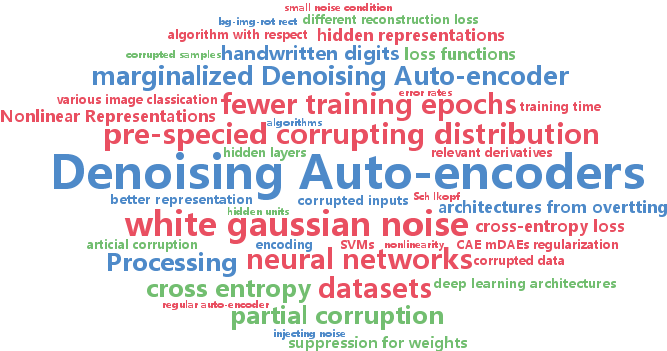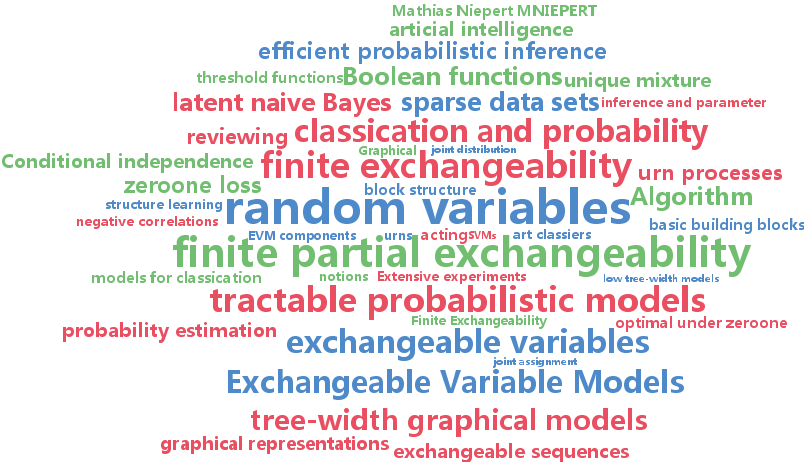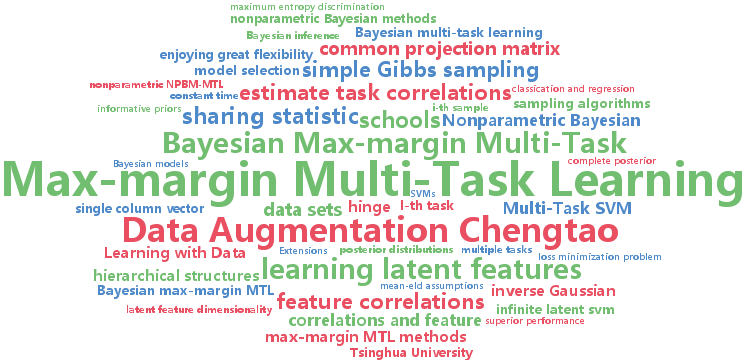svms
-
Minmin Chen and Kilian Weinberger and Fei Sha and Yoshua Bengio
Marginalized Denoising Auto-encoders for Nonlinear Representations (pdf)
Denoising auto-encoders (DAEs) have been successfully used to learn new representations for a wide range of machine learning tasks. During training, DAEs make many passes over the training dataset and reconstruct it from partial corruption generated from a pre-specified corrupting distribution. This process learns robust representation, though at the expense of requiring many training epochs, in which the data is explicitly corrupted. In this paper we present the marginalized Denoising Auto-encoder (mDAE), which (approximately) marginalizes out the corruption during training. Effectively, the mDAE takes into account infinitely many corrupted copies of the training data in every epoch, and therefore is able to match or outperform the DAE with much fewer training epochs. We analyze our proposed algorithm and show that it can be understood as a classic auto-encoder with a special form of regularization. In empirical evaluations we show that it attains 1-2 order-of-magnitude speedup in training time over other competing approaches.
-
Mathias Niepert and Pedro Domingos
Exchangeable Variable Models (pdf)
A sequence of random variables is exchangeable if its joint distribution is invariant under variable permutations. We introduce exchangeable variable models (EVMs) as a novel class of probabilistic models whose basic building blocks are partially exchangeable sequences, a generalization of exchangeable sequences. We prove that a family of tractable EVMs is optimal under zero-one loss for a large class of functions, including parity and threshold functions, and strictly subsumes existing tractable independence-based model families. Extensive experiments show that EVMs outperform state of the art classifiers such as SVMs and probabilistic models which are solely based on independence assumptions.
-
Chengtao Li and Jun Zhu and Jianfei Chen
Bayesian Max-margin Multi-Task Learning with Data Augmentation (pdf)
Both max-margin and Bayesian methods have been extensively studied in multi-task learning, but have rarely been considered together. We present Bayesian max-margin multi-task learning, which conjoins the two schools of methods, thus allowing the discriminative max-margin methods to enjoy the great flexibility of Bayesian methods on incorporating rich prior information as well as performing nonparametric Bayesian feature learning with the latent dimensionality resolved from data. We develop Gibbs sampling algorithms by exploring data augmentation to deal with the non-smooth hinge loss. For nonparametric models, our algorithms do not need to make mean-field assumptions or truncated approximation. Empirical results demonstrate superior performance than competitors in both multi-task classification and regression.
-
Feiping Nie and Yizhen Huang and Heng Huang
Linear Time Solver for Primal SVM (pdf)
Support Vector Machines (SVM) is among the most popular classification techniques in machine learning, hence designing fast primal SVM algorithms for large-scale datasets is a hot topic in recent years. This paper presents a new L2-norm regularized primal SVM solver using Augmented Lagrange Multipliers, with linear-time computational cost for Lp-norm loss functions. The most computationally intensive steps (that determine the algorithmic complexity) of the proposed algorithm is purely and simply matrix-by-vector multiplication, which can be easily parallelized on a multi-core server for parallel computing. We implement and integrate our algorithm into the interfaces and framework of the well-known LibLinear software toolbox. Experiments show that our algorithm is with stable performance and on average faster than the state-of-the-art solvers such as SVMperf , Pegasos and the LibLinear that integrates the TRON, PCD and DCD algorithms.
-
Jie Wang and Peter Wonka and Jieping Ye
Scaling SVM and Least Absolute Deviations via Exact Data Reduction (pdf)
The support vector machine (SVM) is a widely used method for classification. Although many efforts have been devoted to develop efficient solvers, it remains challenging to apply SVM to large-scale problems. A nice property of SVM is that the non-support vectors have no effect on the resulting classifier. Motivated by this observation, we present fast and efficient screening rules to discard non-support vectors by analyzing the dual problem of SVM via variational inequalities (DVI). As a result, the number of data instances to be entered into the optimization can be substantially reduced. Some appealing features of our screening method are: (1) DVI is safe in the sense that the vectors discarded by DVI are guaranteed to be non-support vectors; (2) the data set needs to be scanned only once to run the screening, and its computational cost is negligible compared to that of solving the SVM problem; (3) DVI is independent of the solvers and can be integrated with any existing efficient solver. We also show that the DVI technique can be extended to detect non-support vectors in the least absolute deviations regression (LAD). To the best of our knowledge, there are currently no screening methods for LAD. We have evaluated DVI on both synthetic and real data sets. Experiments indicate that DVI significantly outperforms the existing state-of-the-art screening rules for SVM, and it is very effective in discarding non-support vectors for LAD. The speedup gained by DVI rules can be up to two orders of magnitude.
-
Wei Ping and Qiang Liu and Alex Ihler
Marginal Structured SVM with Hidden Variables (pdf)
In this work, we propose the marginal structured SVM (MSSVM) for structured prediction with hidden variables. MSSVM properly accounts for the uncertainty of hidden variables, and can significantly outperform the previously proposed latent structured SVM (LSSVM; Yu & Joachims (2009)) and other state-of-art methods, especially when that uncertainty is large. Our method also results in a smoother objective function, making gradient-based optimization of MSSVMs converge significantly faster than for LSSVMs. We also show that our method consistently outperforms hidden conditional random fields (HCRFs; Quattoni et al. (2007)) on both simulated and real-world datasets. Furthermore, we propose a unified framework that includes both our and several other existing methods as special cases, and provides insights into the comparison of different models in practice.
-
Shai Shalev-Shwartz and Tong Zhang
Accelerated Proximal Stochastic Dual Coordinate Ascent for Regularized Loss Minimization (pdf)
We introduce a proximal version of the stochastic dual coordinate ascent method and show how to accelerate the method using an inner-outer iteration procedure. We analyze the runtime of the framework and obtain rates that improve state-of-the-art results for various key machine learning optimization problems including SVM, logistic regression, ridge regression, Lasso, and multiclass SVM. Experiments validate our theoretical findings.






